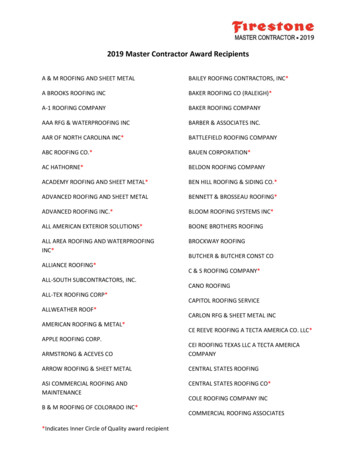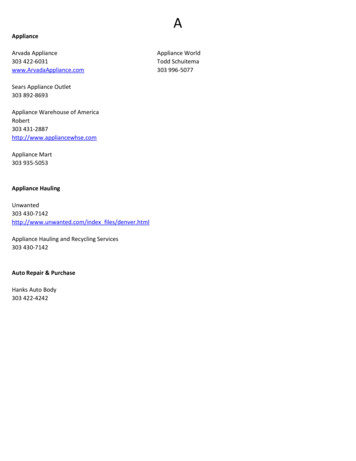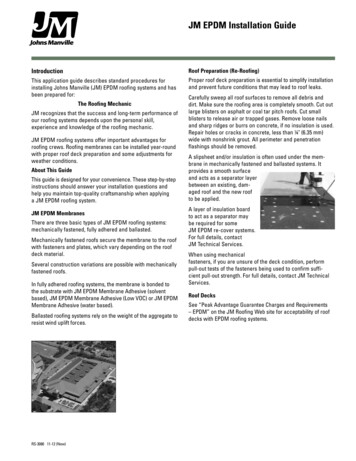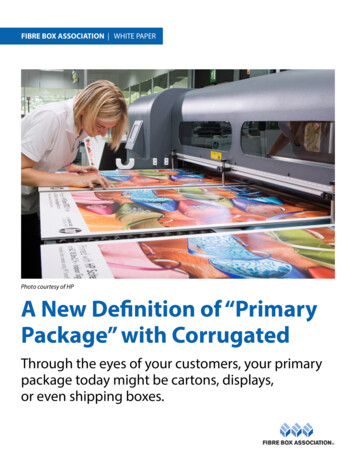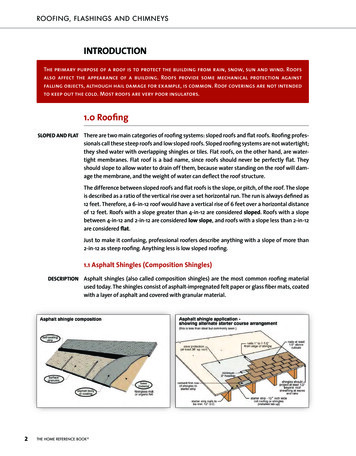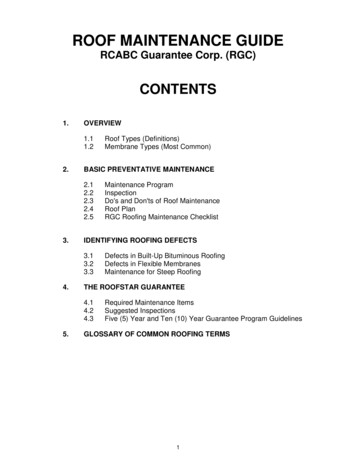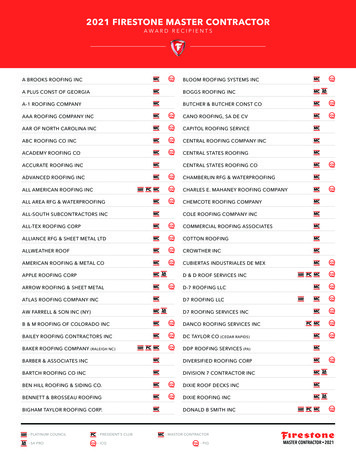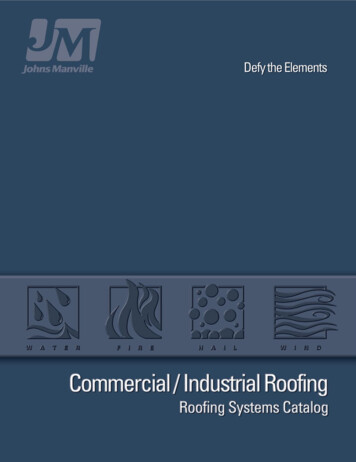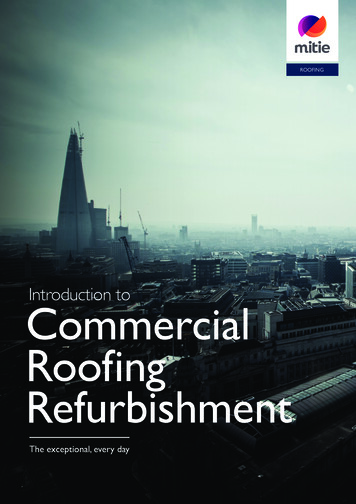
Transcription
frpFiberglass Reinforced PanelsINSTALLATION GUIDE for corrugated roofing panel installationSEQUENTIA SUPER600 SEQUENTIA WEATHERGLAZE
installation guide for corrugated roofing panel installationDISCLAIMERPLEASE READ ALL INSTRUCTIONS BEFORE BEGINNING INSTALLATIONThese guidelines are provided in good faith to help prevent installation problems caused by common errors. The manufacturer and/ordistributor of the product bears no responsibility for installation actions taken or not taken. There are many nuances of installation that areassumed to be general construction knowledge to an experienced installer; such nuances are not included in these instructions. Rather,these installation guidelines are strictly recommendations and are not intended to serve as a step-by-step, foolproof installation checklist.Selection of an experienced FRP installer is the sole responsibility of the project owner and architect. Crane Composites does not acceptany responsibility for job failure resulting from or associated with improper job site environmental conditions.SEE OUR MOST CURRENT SDS AT CRANECOMPOSITES.COM/SDS.HTML PRIOR TO WORKING WITH OUR PRODUCTSGENERAL INFORMATIONSafety InformationWHEN CUTTING OR DRILLING, ALWAYS WEAR PROTECTIVE GLASSES OR GOGGLES AND A FACE MASK WHICH COVERS THE FACEAND MOUTH. Itching due to glass fibers may be avoided by the use of barrier creams on exposed skin areas. Hearing protection is alsorecommended.DO NOT WALK ON PANELS. Observe simple fire precautions. Similar to wood or equal thickness, fiberglass panels can be flash-ignited atapproximately 700 F.ImportantBefore beginning this project, be sure to check your local building codes pertaining to locating and constructing structures; obtain anypermits and inspections that may be required. As required by law, before you dig on construction sites, have all buried utilities (electric, gas,water, phone, cable, etc.) located and clearly marked by a qualified professionalSupplies and EquipmentSTANDARD TOOLS NEEDED Hammer Carpenter square 4’ level Power circular saw Power drive and bits: 1/8” and 3/8” Caulking Gun CaulkCRANE COMPOSITES MATERIALS NEEDED Sequentia FRP Corrugated Panels Sequentia vertical filler strips (R79040) Sequentia horizontal filler strips (R79039) Sequentia end wall or ridgeroll flashing Sequentia galvanized aluminum 1-3/4” gauge nails (R79003)StorageWhile a single panel easily withstands exposure to sunlight and the elements, a stack of fiberglass panels will trap heat and moisture,causing clouding in the panels. To avoid this irreversible effect, panels should be stored in a dry, shaded, well-ventilated area. Store panelson edge or on end. Skids should be elevated at one end with wood spacers.Cleaning InstructionsPanels may we washed with either mild detergent-type cleaners or by steam and high-pressure spray systems. Apply cleaners with spongeor soft brush and rinse thoroughly in cold water to eliminate cleaning agent film build-up. Always follow cleaning agent manufacturer’sinstructions. Test small area before applying over entire surface. Hard water deposits may be removed with a 10% solution of acetic acidin COLD water. Rinse thoroughly. Panels may be waxed to maintain luster and beauty. Always follow wax manufacturer’s applicationinstructions.Minimum Bend Radius(2.67” x 7/8”) Flexing the panel to the point of buckling can cause fracture and rapid deterioration at the fracture point. Install at ambienttemperatures not below 60 F.
3Maximum Recommended SpansThe following data is based upon uniform loading of corrugated FRP panels with a safety factory of 2.5, and fastened as recommended.10 psf20 psf30 psf40 psfWeatherGlaze Panel38”31”27”24”Super 600 Panel38”32”30”24”Corrugated PanelsNOTE: Table is based on a section properties or actual load test. Design loads are governed by local building codes. Conduct codeauthorities for specific load and stresses. Information is provided as preliminary data for designers. It should be checked and verified foruse with a duly licensed engineer or architect.FramingProvide purlin members at recommended maximum intervals required for corrugation section. See chart above for first column.CUTTINGCut fiberglass panels using hand or power saws. Saw blades should be fine-toothed carbide tipped, or safety fabric reinforced abrasivedisc. Face shields and appropriate safety equipment should be worn.DRILLINGAll panels should be pre-drilled not less than 1-1/2” from panel end holes drilled a minimum of 1/16” larger than the fastener diameter.Panels may be drilled singly or several at a time.BASIC FRP INSTALLATION INSTRUCTIONSThese instructions are intended as guidelines for proper installation procedures. In the use of tools, fasteners, sealants, and adhesives,follow manufacturer’s recommended procedures.InstallationFor best protection against prevailing winds and weather, install panels beginning at leeward end of run and work to windward.1. Provide a minimum of one corrugation overlap at sides.2. Provide 8” end-laps for roofs with pitch of less than 4/12. Use 6” end-laps for pitches greater than 4/12.3. Fasten panels through crowns at every second corrugation.Prevailing Wind DirectionFasteners with armored Neoprene washers arerecommended. Space fasteners 6” to 8” on-center alongLeewardpanel edges and 12” to 16” on-center for intermediate raftersand blocking.EndConstruction Notes1.2.3.To avoid deflection of panels, tighten screws until washers will not rotate, then tighten one more turn.Avoid excess burrs on drilled or punched holes to protect Neoprene sealing face.To help insure weather tight roof, apply a small amount of clear sealer at each hole before installing nails or screws.Recommended Overlap(2.67” x 9/16”) Overlaps shown will provide best protection against leakage and air infiltration. Vinyl lap seal and/or mastic must also beused to achieve effective seal on side-laps and end-laps.Typical FastenersInclude aluminum or galvanized nails or wood screws with Neoprene washers. Fastener selection is dependent upon type of corrugationand under structure material used. Panels should be pre-drilled a minimum of 1/16” larger than fastener diameter. #10 x 2” Galvanized “polebarn” screw with 1/2” armored Neoprene washer. 1-3/4” x .145” Alum. helix nail (screw nail) with Neoprene washer.UNDER NO CIRCUMSTANCES should panels be allowed to support undistributed loads such as the weight of a human body.Use only approved roof ladders and planking.
installation guide for corrugated roofing panel installation12BUILDING A PATIO COVER1.11Install concrete slab and footings in accordance with local buildingcode requirements.2NOTE: Building code requirements and available hardware styleswill vary depending on where you live and the size of your plan. Makenecessary adjustments accordingly. Follow manufacturer’s instructionsfor installing anchor brackets.2.698Assemble ledger board and fasten to existing structure using 5” x 1/2” hex head lagscrews. Note: Remove siding from behind ledger board before installing. See diagram 4.7NOTE: Remove siding behind ledger board before mounting ledger to wall. Lag screws mustbe installed into framing. Use appropriate wall anchors on masonry walls. Space fasteners 16”on center as required.3.Fasten 4” x 4” posts to concrete slab/footings using approved steel anchor brackets. Use a4’ level and temporary wood bracing to hold posts in an upright level position. (dia 1)4.Have someone help lift and hold beam for this step. With 4” x 4” posts bracedsecurely, fasten the 4” x 6” beam header to top of posts, using approved steelmounting brackets. See diagram 3.5.Install permanent knee braces from posts to beam, as building code requires.Remove temporary bracing. See diagram 4.6.Cut and install rafters according to Diagrams3. Option: approved rafter hangers maybe used (if not required) in conjunctionwith ledger board. Rafters must install parallel.9.1Top ViewDia. 2Dia. 110' x 10' Roof Plan Shown5-Panel - 6"3'Level Postto VerticalPosition2.Nail vertical edge strips to tops of rafters, using1-1/2” galvanized nails. Hint: drill pilot holes toprevent splitting.3'10. For easier, neater finishing, paint or stain patio cover framing beforeinstalling corrugated panels onto roof.1" Min. PanelOverhangon 3 SidesBlocking3'3'3'2" x 6" RaftersCut to: 9'-9-1/2"1'- 6"CLDia. Determine necessary cuts for horizontal cross strips.NOTE: Cut crown profiles to match-up with vertical edge strips.(See Diagram 5) Test-fit the first cut strip, using a short piece ofcorrugated panel. When satisfied, use test piece as a pattern formarking and cutting remaining horizontal pieces. Cut strips ¼”shorter than needed to allow shifting. Tack horizontal strips to topsof blocking boards using 1” nails in recesses between crowns.Continue checking alignment of strips, using a small strip ofcorrugated panel.ExistingStructureLedger Board10' Panel Length8.For ease of assembly, install 2” x 6”solid blocking as suggested in DiagramOption: blocking can be staggered differentlyand/or reduced to 2” x 4” to suit personal taste.539' to Centerline of Post7.4Dia. 42x6 Rafter DetailsKnee Brace Details" O.C.)5" x 1/2" Lag Screws (Spaced 1614"4"2" x 6"LedgerBoard2" x 2"LedgerSteelBracket*45 Angle cuts atends of Braces18"4" x 6"HeaderBeam31/2"21/8"18"4" x 4" Post* Follow manufacturer’s instructions for installing21/8"31/2"5" x 1/2"Lag Screws/2"-13211. Follow corrugated panel installation instructions for fastening panels to roof framing.Dia. 512. Install corrugated end wall flashing: Place flashing behind existing siding where possible.Use approved mastic to bond flashing to masonry walls. WARNING: Do not step or kneel oncorrugated panels without using planks to distribute weight.Panel FastenersHorizontal StripVertical Strip Clear SealerSequentia PanelScrew-TypeFastenerNail-TypeFastener2" x 6" Solid Blocking2" x 6" Solid Blocking2" x 6" Rafter
5BUILDING A GREENHOUSE1.Choose a good building site, preferably: level ground with good drainage, sunny area away fromlarge trees, and close access to water and electricDia. 1BACKLeave 1-1/2” gap for2x6 ridge board.Cut Rafterends at 45º.3.Gable Rafter59”2.Choose desired footings/flooring materials and install accordingly. Make gravel floors 3’ largerthan greenhouse footprint, make pouredconcrete floors 8” larger. Wood floors should be 1” smaller than footprint, so corrugated panelscan extend below the framed walls.2x22x22x2Staggerblockingfor easierassembly.Cut and lay out the front, back, and 2 side wall sections, as shown in Diagrams 1,2, & 3.Assemble framing members, using 10d galvanized nails or 3” construction screws. Drill pilot holesto avoid splitting dry lumber.2x4SideWall6’2x4SideWall8’4.Erect assembled wall sections on footings/flooring surface. Fasten walls at corners, using 10dgalvanized nails or 3” construction screws. Square 4 corners, using a carpenter square or the 3,4, 5 method.5.Cut 2x6 ridge board to length and fasten between front and back gables.6.Mark rafter spacing and install rafters using 10d galvanized nails or 3” construction screws.7.Cut and install solid blocking between rafters using 10d galvanized8.Nail vertical edge strips to tops of rafters and vertical wall members, using 1-1/2” galvanized nails.Drill pilot holes to prevent splitting.Dia. 2FRONTAdjust size of gable ventopenings to acceptselected vents.3’2x2Gable RafterAdjust size ofdoor opening toaccept desireddoor type.2x4SideWall6’2x4SideWall58’Dia. 3Left and Right SidewallsStaggerblockingfor �Note: Use treated lumber for bottom sill plates.2Make concrete floors 8” larger than building footprint.Optional: Framing can be fastened to concrete floorusing suitable anchoring hardware.Note: Center lower end of each rafter oververtical side wall members. Mark ridge boardfor equal spacing of top rafter ends.Important: Rafters must install parallel toeach other for panel corrugation toalign properly.Cut front edge of lower blockMRK EX Note: Use sill sealer under bottom sill plates.76Cut intermediate raftersto match gable rafters.24”O.C.24”
9.Determine necessary cuts for horizontal cross strips.129Prevailing Wind Direction8NOTE: Cut crown profiles to match-up with vertical edgestrips. Test-fit the first cut strip, using a short piece ofcorrugated panel. When satisfied, use the test piece as apattern for marking and cutting additional horizontal strips.Cut strips 1/4” shorter than needed to allow shifting.Tack horizontal strips to all horizontal framing members,using 1” galvanized nails in recesses between crowns.11Continue checking alignment of strips, using a small stripof corrugated panel.Note: Install panels on side walls first.Install roof panels last.131410. For easier, neater finishing, paint or stain greenhouseframing before installing corrugated panels.11. Follow corrugated panel installation instructions forfastening panels to framing. Install vertical wall panels first.Install roof panels last.12. Install corrugated ridge flashing: use approved mastic orcaulk to bond flashing to fiberglass panels. Flashing can be further secured using panel nails or screws and sealer.13. Install gable vents after corrugated panels have been installed. Use layered foam enclosures at top and bottom of vents to fill voids.14. Install assembled custom door or ready-made door.FOR QUESTIONS OR CONCERNS, PLEASE CONTACT:Crane Composites Customer Service Department1.800.435.0080 1.815.467.8600A global leading provider of resilient wall and ceiling coverings. Kemlite was established in 1954 and the company changed names to Crane Composites in 2007. CraneComposites is headquartered in Channahon, IL and all our products are manufactured in the United States. We work with hundreds of distributors, ensuring our products areeasily accessible and readily available to our customers.The following are trademarks of Crane Composites, Inc. or a related company: Sequentia, Super 600, WeatherGlaze, Kemlite, Kemply, Surfaseal, Silhouette Trims and Varietexcranecomposites.com2517 REV. 4 05.2020 (8848) 1.800.435.0080 sales@cranecomposites.com
installation guide for corrugated roofing panel installation. BUILDING A GREENHOUSE 1. Choose a good building site, preferably: level ground with good drainage, sunny area away from large trees, and close access to water and electric 2. Choose desired footings/flooring materials and install accordingly. Make gravel floors 3' larger

